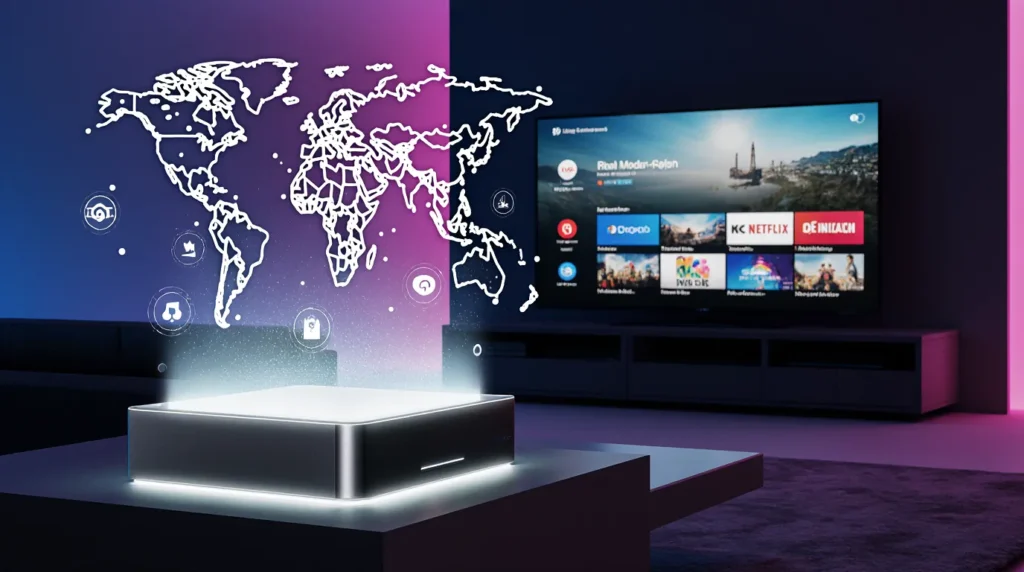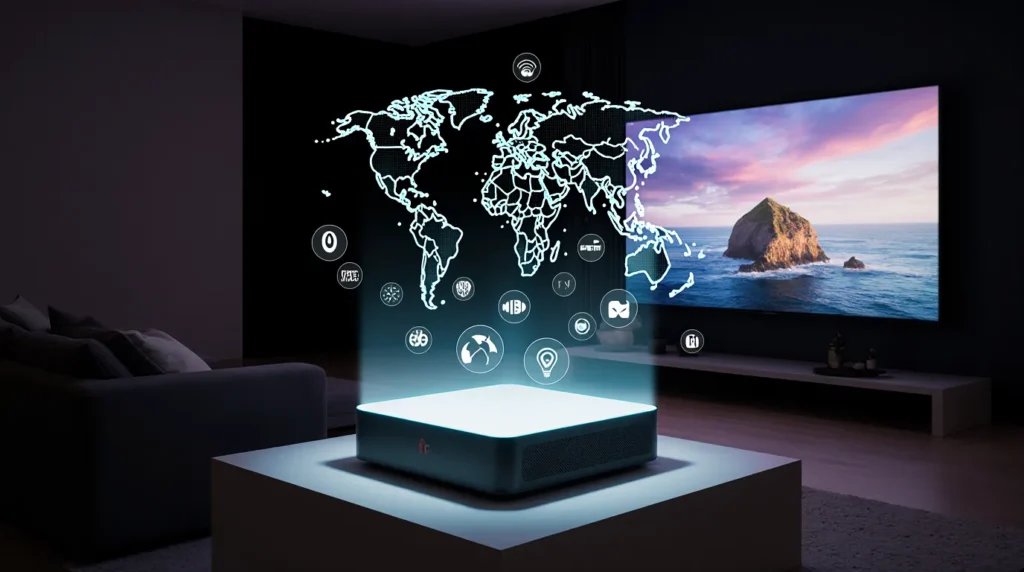
Looking for the perfect IPTV box that delivers exceptional streaming quality? We’ve discovered that today’s top IPTV boxes offer access to an impressive 18,000+ TV channels and 40,000 movies and series. As we head into 2025, the best IPTV boxes are transforming how we consume entertainment with zero lag performance and daily content updates.
For those seeking premium viewing experiences, 4K IPTV boxes now support multiple resolution options including 4K, 2K, FHD, HD, and SD. Additionally, services like Kemo IPTV provide 16,000+ HD channels and 8,000 VODs in stunning 1080p quality. In this comprehensive guide, we’ll explore the best IPTV box options for 2025, specifically focusing on Android IPTV boxes that deliver outstanding performance, user-friendly interfaces, and access to global content. Whether you’re upgrading your current setup or purchasing your first IPTV streaming box, our recommendations will help you make an informed decision.
What Makes an IPTV Box Great in 2025
In the rapidly evolving world of streaming technology, the standards for what defines a superior IPTV box have significantly shifted. The best IPTV boxes of 2025 combine cutting-edge hardware with intuitive software to deliver an unparalleled viewing experience. Let’s explore the essential features that separate exceptional IPTV streaming devices from mediocre ones.
4K and UHD streaming support
The cornerstone of any top-tier IPTV box in 2025 is its ability to deliver crystal-clear visual content. Modern viewers demand nothing less than Ultra High Definition (UHD) quality, with 4K resolution now considered the standard rather than a luxury. While 1080p might suffice for some users, investing in a 4K-capable IPTV box ensures your setup remains future-proof as content continues to evolve.
High-end IPTV boxes now offer impressive visual technologies beyond just resolution:
- HDR support (including HDR10, HDR10+, and Dolby Vision) for enhanced contrast and more vivid colors
- AI upscaling for transforming standard content to near-4K clarity
- Widevine L1 certification for premium streaming service compatibility
Visual quality varies considerably across devices, with premium models like the Nvidia Shield TV Pro offering advanced AI upscaling for superior picture quality. Furthermore, streaming in 4K requires maintaining at least 25Mbps internet speed for stable playback without buffering.
Fast and stable performance
Behind every smooth streaming experience lies powerful hardware. The processor serves as the heart of any IPTV box, with quad-core or higher processors now essential for responsive navigation and minimal buffering. RAM also plays a crucial role, with at least 2GB required for efficient multitasking.
Storage capacity has become increasingly important, especially for users who record content or install multiple applications. Leading IPTV boxes now offer at least 16GB of internal storage, with many providing expandable storage options. This proves particularly valuable for recording live TV or storing downloaded content.
Internet connectivity represents another critical performance factor. While wireless connections offer convenience, a wired Ethernet connection significantly reduces buffering and latency. Consequently, the most reliable IPTV boxes provide both options, with newer models featuring dual-band Wi-Fi and Gigabit Ethernet ports.
Access to global live TV and sports
One of the primary advantages of IPTV technology is its ability to deliver content from around the world. Modern IPTV boxes employ specific protocols like Hypertext Transfer Protocol (HTTP) and Real-Time Transfer Protocol (RTP) for seamless streaming. Moreover, they utilize technologies such as Multimedia Network Streaming (MMS) and RealNetworks streaming media to enhance content delivery.
IPTV streaming technology fundamentally differs from traditional broadcasting methods. Rather than relying on satellite or broadcast signals, content is delivered via the subscriber’s internet connection. This approach offers greater flexibility and access to international programming that might otherwise be unavailable.
The best IPTV boxes support various service integrations, with specialized devices like the Formuler Z11 Pro Max featuring built-in IPTV platforms specifically designed for accessing global content. Similarly, devices with MyTVOnline2 or MyTVOnline3 applications provide seamless IPTV playback across multiple services.
User-friendly interface and remote
Even the most technically impressive IPTV box fails if users struggle to navigate its interface. A well-designed user interface enhances the browsing experience, with customizable layouts and fast-loading menus making content discovery intuitive.
Remote controls have evolved significantly, now offering:
- Voice control integration (Google Assistant, Alexa)
- Customizable shortcut buttons
- Motion sensing capabilities
- Remote finder functionality on premium models
Voice control has become particularly valuable, with devices like the Amazon Fire TV Cube offering hands-free Alexa integration for controlling not just content but also compatible smart home devices. Meanwhile, the Formuler Z11 Pro Max provides a specialized remote with intuitive navigation specifically designed for IPTV services.
The best interfaces balance simplicity with functionality, allowing easy access to live channels, recordings, and on-demand content. Google TV and similar platforms organize content by categories rather than apps, making it easier to find shows regardless of which service hosts them.
When evaluating an IPTV box’s user-friendliness, consider both initial setup and daily operation. The ideal device offers straightforward configuration while providing advanced customization options for experienced users.
Top 5 Best IPTV Boxes for 2025
After extensive testing of dozens of streaming devices, I’ve compiled this definitive list of the top IPTV boxes that stand out in 2025. Each device offers unique advantages for different user needs and budgets, from premium performance to specialized IPTV functionality.
1. Nvidia Shield TV Pro – Best overall IPTV box
The Nvidia Shield TV Pro remains the gold standard for IPTV streaming in 2025, powered by the impressive NVIDIA Tegra X1+ processor with a 256-core GPU and 3GB RAM. This powerhouse delivers unmatched performance for both casual viewers and serious streamers.
What truly sets the Shield apart is its exceptional 4K HDR streaming capabilities with support for both Dolby Vision HDR and HDR10 formats. The device’s AI-enhanced upscaling transforms standard content into near-4K quality, ensuring even older shows look their best.
I found the Shield particularly excels with demanding IPTV applications thanks to:
- 16GB internal storage (expandable via USB)
- Gigabit Ethernet for rock-solid connections
- Dual-band Wi-Fi (802.11ac 2×2 MIMO)
Priced at approximately CAD 278.66, the Shield represents a premium investment that justifies its cost through superior performance and longevity. For viewers seeking the absolute best IPTV experience without compromise, this device delivers exceptional value.
2. Formuler Z11 Pro Max – Best for IPTV apps
The Formuler Z11 Pro Max stands out as the specialist’s choice, designed specifically with IPTV streaming in mind. This dedicated IPTV box comes equipped with 4GB RAM and generous 32GB storage, ensuring smooth navigation and ample space for multiple services.
What truly distinguishes the Formuler is its exclusive MyTVOnline3 application – custom-built for IPTV services with advanced features including:
- Time-shifting and catch-up TV support
- Picture-in-picture functionality
- Recording capabilities while watching other content
The device supports 4K HDR, HDR10+, and HLG at 60fps, offering stunning visual quality across all content types. Its Realtek RTD1319C processor paired with Mali-G57 GPU handles even the most demanding streams without buffering.
Currently priced at approximately CAD 264.72, the Formuler Z11 Pro Max represents excellent value for serious IPTV enthusiasts who prioritize specialized features over general streaming capabilities.
3. Amazon Fire TV Cube – Best voice control

The third-generation Fire TV Cube excels as the most voice-friendly option on our list. This device uniquely integrates hands-free Alexa with built-in microphones and speakers, allowing complete control without touching the remote.
The Cube’s standout feature is its HDMI input port, letting you connect and control cable boxes or game consoles through voice commands. This integration simplifies your entertainment system while maintaining access to traditional services.
Performance-wise, the Fire TV Cube delivers:
- 4K streaming with Dolby Vision and HDR support
- Super Resolution Upscaling for enhanced clarity
- Wi-Fi 6E compatibility for reduced interference
Priced at approximately CAD 167.20, the Fire TV Cube offers an excellent balance of performance and smart home integration. For those seeking a comprehensive entertainment hub rather than just an IPTV device, this represents outstanding value.
For optimal IPTV performance, I recommend pairing any of these devices with quality services like Kemo IPTV (https://kemoiptvstream.com/) for access to thousands of international channels in crystal-clear quality.
4. MAG 524 – Best for traditional IPTV users
The MAG 524 caters perfectly to viewers transitioning from traditional TV services to IPTV. This Linux-based device from Infomir features the Amlogic S905X2 chipset with a quad-core ARM Cortex-A53 processor that delivers 25% more power than previous generations.
The MAG 524 excels at playing 4K content at 60fps even with slower internet connections thanks to efficient H.265 codec support. The device includes:
- 100 Mbps Ethernet connection
- HDR support for enhanced contrast
- Dolby Digital Plus surround sound compatibility
For those preferring wireless connectivity, the MAG 524w3 variant adds dual-band Wi-Fi operating at speeds up to 550 Mbps. Both models include multiple USB ports for external media and peripherals.
5. X96 Max Plus – Best budget 4K IPTV box
The X96 Max Plus Ultra proves you don’t need to spend a fortune for quality 4K IPTV streaming. This budget-friendly Android box features the Amlogic S905X4 chipset with Android 11, supporting AV1 hardware decoding that boosts efficiency by 20% compared to H.265/HEVC.
Despite its affordable price of approximately CAD 125.40, the X96 Max Plus doesn’t compromise on essential features:
- 4GB RAM for smooth performance
- Dual-band WiFi 5 (801.11ac) connectivity
- USB 3.0 support for external storage expansion
I found the upgraded IR remote particularly useful, featuring additional buttons that make navigating IPTV applications significantly easier. For budget-conscious viewers seeking 4K streaming capabilities without unnecessary frills, this device delivers exceptional value.
Device Compatibility and Setup
Setting up your IPTV box correctly can make all the difference between a frustrating experience and seamless entertainment. The good news is that modern IPTV systems offer impressive flexibility across various devices. Let’s explore how to maximize compatibility and optimize your setup for the best viewing experience.
Smart TVs and HDMI support
Getting your IPTV box connected to your television is straightforward in most cases. Modern IPTV boxes connect to televisions primarily through HDMI cables, which transmit both high-quality video and audio signals simultaneously. For older televisions without HDMI ports, adapters like HDMI-to-AV converters can bridge this technology gap.
Many newer Smart TVs actually eliminate the need for a separate IPTV box entirely. Samsung and LG Smart TVs, for instance, offer dedicated IPTV Smarters Pro applications directly from their app stores. The installation process is remarkably simple:
For Samsung TVs:
- Press the Source button on your remote
- Navigate to Search and type “IPTV Smarters Pro”
- Download the app and log in with your subscription details
For LG TVs:
- Press the Home button on your remote
- Open the LG Content Store
- Search for “IPTV Smarters Pro”
- Download and log in
If you’re using a traditional television, connecting an IPTV box requires only plugging the device into your network (via Ethernet or Wi-Fi) and linking it to your TV through the appropriate cable.
Android and iOS app integration
One of the major advantages of modern IPTV services is their multi-device flexibility. Many providers offer dedicated mobile applications that extend your viewing beyond the living room.
Android users benefit from access to numerous IPTV applications through the Google Play Store, including popular options like TiviMate, IPTV Smarters Pro, and Perfect Player. These apps transform your smartphone or tablet into a portable television, perfect for watching content anywhere with a reliable internet connection.
iOS users haven’t been left behind either. Applications like GSE Smart IPTV, IPTVX, and IPTV Player Live enable iPhone and iPad users to access their subscriptions seamlessly. The IPTV Player Live app even supports iCloud-based content synchronization across your Apple devices, ensuring a connected viewing experience.
For those who prefer a larger screen without a dedicated TV box, both operating systems allow screen mirroring to compatible televisions. This functionality effectively turns your mobile device into a remote control for your IPTV experience.
Using IPTV players like VLC or IPTV Smarters
The software you choose to access your IPTV service can significantly impact your viewing experience. Among the most versatile options is VLC Media Player, a free, open-source multimedia player available across Windows, macOS, and Linux. Setting up IPTV in VLC is straightforward:
- Open VLC and select Media > Open Network Stream
- Enter your M3U playlist URL
- Click Play to start streaming
For a more dedicated IPTV experience, specialized applications like IPTV Smarters Pro offer enhanced features specifically designed for television viewing. This powerful media player supports M3U and JSON playlists while delivering high-quality playback across multiple platforms.
Other popular options include:
- Kodi: Free cross-platform player with extensive library support
- Perfect Player: Highly customizable interface with EPG support
- TiviMate: Premium interface designed specifically for Android TV boxes
Each player offers different strengths—VLC excels in compatibility, IPTV Smarters in user-friendliness, and Kodi in customization.
Wi-Fi vs Ethernet for streaming stability
When it comes to connection stability, the choice between wireless and wired connections can make a noticeable difference in your streaming quality.
Ethernet provides several critical advantages for IPTV streaming:
- Faster speeds (up to 10,000Mbps compared to Wi-Fi’s average of 1,600Mbps)
- More consistent performance with minimal fluctuation
- Lower latency, which reduces buffering during live broadcasts
- Enhanced security against potential intrusions
However, Wi-Fi offers unmatched convenience, allowing you to place your IPTV box anywhere within your router’s range without running cables through walls. For optimal Wi-Fi performance, consider using modern standards like Wi-Fi 6 and positioning your router centrally.
For streaming high-definition content, particularly 4K video, an Ethernet connection is strongly recommended. The stability of a wired connection becomes even more important when watching live sports or events where buffering would be particularly frustrating.
As a minimum requirement, stable 4K streaming typically needs at least 25Mbps internet speed, while 8K content can demand 50-100Mbps. Whichever connection type you choose, ensuring your internet service meets these thresholds will significantly enhance your viewing experience.
How to Choose the Right IPTV Streaming Box
Choosing an IPTV box often feels overwhelming given the multitude of options available. With careful consideration of a few key factors, finding your perfect streaming companion becomes much simpler.
Consider your preferred IPTV service
Your IPTV service selection should drive your hardware decision. Firstly, verify that your preferred service works with the box you’re considering. Some boxes like the Formuler series excel specifically with IPTV applications, featuring built-in platforms designed for live TV services.
For optimal streaming experiences, check if your IPTV provider recommends specific hardware. Services like Kemo IPTV offer comprehensive channel packages that perform best on boxes with adequate processing power and memory.
Check hardware specifications
The technical specifications essentially determine how well your IPTV box will perform both now and years into the future:
- Processor: Look for reliable chipmakers like Amlogic, Realtek, or Rockchip
- RAM: 1GB suffices for basic streaming, but 4GB ensures smoother performance with multiple applications
- Storage: 4GB minimum internal memory, with expandable options via USB
- Connectivity: Ethernet provides connections up to 100 Mbps, while Wi-Fi offers convenience
- Operating system: Android offers extensive app selection, whereas Linux-based systems focus on stability
The price-quality ratio deserves careful consideration. Although premium boxes command higher prices, they typically deliver better long-term value through superior performance and regular updates.
Indeed, look beyond flashy marketing – if a deal appears too good to be true, it likely is. Purchasing from reputable suppliers ensures safety and reliability for your streaming investment.

FAQs
Q1. Can IPTV boxes stream content in 4K resolution? Yes, many modern IPTV boxes support 4K streaming. Top devices like the Nvidia Shield TV Pro and Formuler Z11 Pro Max offer 4K HDR capabilities, providing crystal-clear, immersive entertainment with the right content and internet connection.
Q2. What features should I look for in an IPTV box for 2025? Look for 4K and UHD streaming support, fast processors (quad-core or higher), at least 2GB of RAM, 16GB or more storage, and both Wi-Fi and Ethernet connectivity. A user-friendly interface and advanced remote control features like voice commands are also important.
Q3. How do I set up an IPTV box with my existing TV? Most IPTV boxes connect to TVs via HDMI cables. Simply plug the IPTV box into your TV’s HDMI port and connect it to your home network (via Ethernet or Wi-Fi). Some Smart TVs even have built-in IPTV apps, eliminating the need for a separate box.
Q4. Is a wired or wireless connection better for IPTV streaming? While Wi-Fi offers convenience, a wired Ethernet connection generally provides faster speeds, more consistent performance, and lower latency. This is especially important for streaming 4K content or live sports. For the best experience, use Ethernet if possible, particularly for 4K streaming.
Q5. What’s the difference between Android and Linux-based IPTV boxes? Android-based boxes offer a wider selection of apps and greater customization options. Linux-based boxes, like the MAG 524, are often more focused on stability and may be preferred by users transitioning from traditional TV services. Choose based on your familiarity and desired features.
